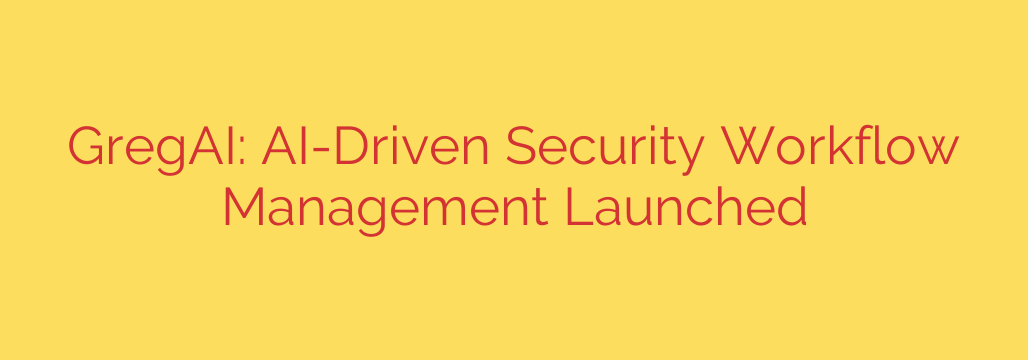
Revolutionizing SecOps: How AI is Automating Cybersecurity Workflows
In today’s complex digital landscape, security operations (SecOps) teams are facing an unprecedented challenge. They are inundated with a constant stream of alerts from a myriad of security tools, from firewalls and endpoint detection systems to cloud monitoring platforms. This overwhelming volume of data often leads to a critical problem: alert fatigue. When analysts are forced to sift through thousands of notifications, the risk of missing a genuine, high-priority threat increases dramatically.
The traditional approach of manual triage and response is no longer sustainable. The sheer speed and sophistication of modern cyberattacks demand a faster, more intelligent, and more efficient way to manage security workflows. This is where a new generation of AI-driven security management platforms is making a significant impact.
The Challenge with Traditional Security Management
For years, security teams have relied on tools like Security Information and Event Management (SIEM) and Security Orchestration, Automation, and Response (SOAR) platforms. While powerful, these systems often require extensive manual configuration, complex rule-writing, and constant human intervention.
An analyst’s typical day involves manually investigating alerts, correlating data from different sources to understand context, and deciding on a course of action. This process is not only time-consuming and repetitive but also highly dependent on the individual analyst’s experience level, leading to inconsistent responses across the team. The result is a reactive security posture where teams are constantly playing catch-up.
How AI is Transforming Security Workflows
AI-powered security workflow management is changing this paradigm by introducing intelligent automation at the core of the security process. Instead of simply collecting logs or executing pre-defined playbooks, these advanced systems use machine learning to understand, prioritize, and even act on threats in real time.
Here are the key ways AI is revolutionizing security operations:
Intelligent Alert Triage and Prioritization: AI algorithms can analyze incoming alerts from all your security tools in milliseconds. By correlating data points, understanding historical context, and recognizing subtle patterns, the AI can distinguish between a low-priority anomaly and a critical, unfolding attack. This allows human analysts to focus their attention on the threats that truly matter, cutting through the noise and drastically reducing the risk of a critical event being missed.
Automated Investigation and Enrichment: Once a high-priority alert is identified, an AI-driven platform can automatically begin the investigation. It can gather relevant data from other systems, enrich the alert with threat intelligence, and present a complete, contextualized summary to the analyst. This slashes investigation time from hours to minutes, enabling faster and more informed decision-making.
Guided and Automated Response Actions: These platforms don’t just identify problems; they help solve them. Based on the nature of the threat, the AI can recommend a specific response playbook or, where configured, take direct action. This could include automatically quarantining an infected endpoint, blocking a malicious IP address at the firewall, or disabling a compromised user account. This automation ensures that responses are swift, consistent, and follow best practices every time.
The Tangible Benefits for Your Security Team
Adopting an AI-driven approach to security management isn’t just about using the latest technology; it’s about achieving measurable improvements in your security posture and operational efficiency.
The primary benefits include:
- Drastically Reduced Mean Time to Respond (MTTR): By automating the detection, investigation, and response cycle, security teams can contain threats significantly faster, minimizing potential damage.
- Increased Analyst Efficiency and Focus: Freeing analysts from repetitive, low-level tasks allows them to concentrate on more strategic activities like threat hunting, system hardening, and architectural improvements.
- Bridging the Cybersecurity Skills Gap: AI acts as a force multiplier, enabling smaller or less experienced teams to perform at a much higher level. The system’s built-in intelligence provides guidance and ensures that even junior analysts can effectively handle complex incidents.
- Enhanced Security Posture: With 24/7 automated monitoring and consistent, rapid responses, the organization’s overall resilience against cyberattacks is fundamentally strengthened.
Actionable Tips for Adopting AI in Your SecOps
Integrating AI into your security workflows requires careful planning. To ensure a smooth transition and maximize value, consider the following steps:
- Audit Your Current Processes: Before you can automate, you must understand your existing workflows. Document how your team currently handles alerts, from initial detection to final resolution. Identify bottlenecks and areas ripe for automation.
- Prioritize Integration Capabilities: An AI platform is only as good as the data it receives. Ensure any solution you consider can seamlessly integrate with your existing security stack, including your SIEM, EDR, cloud, and identity management tools.
- Foster a Culture of Trust and Collaboration: Introduce AI as a tool to augment, not replace, your human experts. Train your team on how to work alongside the AI, leveraging its insights to enhance their own skills and decision-making.
The future of cybersecurity lies in the intelligent partnership between human expertise and machine efficiency. By embracing AI-driven workflow management, organizations can finally move from a reactive, overwhelmed state to a proactive, resilient, and highly effective security posture.
Source: https://www.helpnetsecurity.com/2025/07/29/intruder-gregai/








